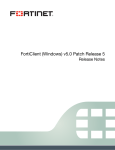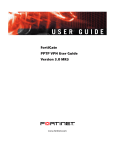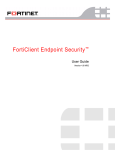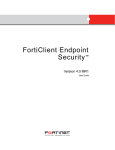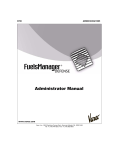Download Fortinet 3000B User's Manual
Transcript
Light Icon QuickStart Guide Description The light flashes orange when packets are sent and received on the Ethernet port 1 and 2. FortiManager-3000B Power indicator is blue when the FortiManager system is on. The light flashes blue when reading the boot device. Hard Disk Upper LED Blue when the hard disk is properly inserted into the drive bay and the FortiManager is plugged in to a power source. Hard Disk Lower LED Flashes blue when reading and writing to the hard disk. PS RST 2 DISK DRIVE LEGEND HDD 1 (P0) 1 POWER ACTIVITY HDD 4 (P3) HDD 2 (P1) HDD 5 (P4) HDD 3 (P2) HDD 6 (P5) Visit these links for more information and documentation for your Fortinet product. • • • • © Copyright 2009 Fortinet Incorporated. All rights reserved. Products mentioned in this document are trademarks or registered trademarks of their respective holders. Regulatory Compliance FCC Class B Part 15 CSA/CUS 11 March 2010 Technical Documentation - http://docs.fortinet.com Fortinet Knowledge Center - http://kb.fortinet.com Fortinet Technical Support - http://support.fortinet.com Training Services - http://campus.training.fortinet.com 02-40000-112745-20091027 Package Contents Connector Type Speed Protocol Description Port 1 to 4 RJ-45 100/1000 Base-T Ethernet Connection to the internal network. CONSOLE DB9 9600 bps 8/N/1 RS-232 serial Optional connection to the management computer. Provides access to the command line interface. USB USB USB For future use. Front LED Indicators Power Button Power Suppy Alarm Reset Button ® PS RST QuickStart Guide 2 FortiManager-3000B 1 PS RST DISK DRIVE LEGEND 2 POWER ACTIVITY DISK DRIVE LEGEND Back HDD 1 (P0) HDD 2 (P1) HDD 3 (P2) HDD 4 (P3) EMPTY EMPTY Straight-through and cross over Ethernet cables USB (Behind front panel) DB9 Serial connection USB for future use Ethernet connections HDD 3 (P2) HDD 4 (P3) 1 POWER ACTIVITY Tools and Documenation Copyright 2008 Fortinet Incorporated. All rights reserved. Trademarks Products mentioned in this document are trademarks. DB-9 Serial Cable REGISTER 4 hot-swappable hard disks Power Cables Power connections HDD 1 (P0) HDD 2 (P1) Ethernet connections Connecting Connect the following to the FortiManager system. Ensure the FortiManager system is placed on a stable surface or securely mounted in a 19” rack. • Insert the hard disks included in the FortiManager package into the bays of the FortiManager unit, starting in bay 1. Use the diagram on the front panel as a guide. • Insert a network cable to port 1. Insert the other end to the router or switch connected to the network. • Connect one power chord to a power supply. Connect the other power cord to an alternate power source if available. • Connect the Power Cord to a surge protected power bar or power supply. • Press the Power button to turn on the FortiManager unit. • The power LED appears blue and the hard disk icon LED flashes blue while the system boots. • • Power connections Null modem cable connects to serial port on management computer. For more information, see the FortiManager Install Guide. Straight-through Ethernet cable connects to hub or switch on the network. Configuration Tools Web-based manager Command Line Interface (CLI) The FortiManager web-based manager is an easy to use management tool. Use it to configure the administrator password, the interface and default gateway addresses, and the DNS server addresses. The CLI is a full-featured management tool. Use it to configure the administrator password, the interface addresses, the default gateway address, and the DNS server addresses. To configure advanced settings, see the Tools and Documentation CD-ROM. Requirements: • An Ethernet connection between the FortiManager system and management computer. • A web browser such as FireFox 2.0 and higher or Internet Explorer 6.0 and higher on the management computer. Requirements: • The DB9 serial connection between the FortiManager system and management computer. • A terminal emulation application (HyperTerminal for Windows) on the management computer. Collecting Information General settings Interface configuration IP: ____.____.____.____ admin ____.____.____.____ Administrative account settings User name Netmask: Password (none) Port 2 Interface: IP: ____.____.____.____ Network Settings Default Gateway: ____.____.____.____ Netmask: ____.____.____.____ Primary DNS Server: ____.____.____.____ Port 3 Interface: IP: ____.____.____.____ Secondary DNS Server: ____.____.____.____ Netmask: ____.____.____.____ IP: ____.____.____.____ Netmask: ____.____.____.____ Port 1 Interface: Port 4 interface: The interface IP address and netmask must be valid for the internal network. A default gateway is required for the FortiGate unit to route connections to the Internet. Factory default settings Port 1 interface 192.168.1.99 Port 2 interface 0.0.0.0 Port 3 interface 0.0.0.0 DHCP server on Internal interface 0.0.0.0 To reset the FortiGate unit to the factory defaults, in the CLI type the command execute factory reset Configuring Web-based Manager Command Line Interface Use the following procedure to connect to the web-based manager for the first time. Configuration changes made with the Web Config are effective immediately without resetting the unit or interrupting service. The unit has serial port. Use the null modem cable to connect it to your management computer. To connect to the web-based manager 1. Connect the Port 1 interface of the unit to Ethernet port of the management computer. Use a cross-over Ethernet cable to connect the devices directly. Use straight-through Ethernet cables to connect the devices through a hub or switch. 2. Configure the management computer to be on the same subnet as the Port 1 interface. To do this, change the IP address of the management computer to 192.168.1.2 and the netmask to 255.255.255.0. 3. To access the web-based manager, in your browser, go to https://192.168.1.99 (remember to include the “s” in https://). 4. Type admin in the Name field and select Login. After connecting to the Web-based manager, you can configure the unit IP address, DNS server IP address, and default gateway to connect the unit to the network. To configure interfaces 1. 2. 3. 4. Go to System Settings > Network > Interface. Click the edit icon to configure each interface. Set the IP address and netmask for the interface. Click OK. To configure the Primary and Secondary DNS server IP addresses 1. Go to System Settings > Network > DNS, enter the Primary and Secondary DNS IP addresses click Apply. To connect to the unit 1. Use a null modem cable to connect the serial port to the management computer serial port. 2. Start a terminal emulation program (such as HyperTerminal) on the management computer. Use these settings: Baud Rate 9600, Data bits 8, Parity None, Stop bits 1, Flow Control None. 3. At the login: prompt, type admin and press Enter twice. (The login prompt is preceded by the server default host name.) After connecting to the CLI, you can configure the unit IP address, DNS server IP address, and default gateway to connect the unit to the network. To configure the unit using the CLI 1. Set the IP address and netmask of the Port1 interface. config fmsystem interface edit port1 set ip <intf_ip>/<netmask_ip> end 3. Configure the primary and secondary DNS server IP addresses. config fmsystem dns set primary <dns-server_ip> set secondary <dns-server_ip> end 1. Go to System Settings > Network > Static Routing and select Create New. 2. Set Gateway to the Default Gateway IP address and click OK. 4. Configure the default gateway. config fmsystem route edit 1 set device <interface> set dst <destination_ip> set gateway <gateway_ip> end Adding an administration password Shutting down the unit By default, the admin user does not have a password. To restrict access to the unit management account, add password for the admin user account. When powering off the unit, always shut down the unit using the following procedures before disconnecting the power supply. Not following this procedure can increase the risk of damaging the hard disk. To configure a Default Gateway To add the admin user account password 1. 2. 3. 4. 5. 6. Go to System Settings > Administration > Administrator. Select the admin user name to edit the profile. Select the Change Password checkbox. Enter the old password. Enter a new password in the New Password and Confirm Password fields. Click OK. Adding an administration password using the CLI To add an administration password in the CLI enter the following commands: config fmsystem admin user edit admin set password please input password value <password> To power off the unit 1. 2. 3. 4. Go to System Settings> General > Dashboard. In the System Operation list, select Shut Down. Click Go. Once the indicates the shut down procedure has completed, disconnect the unit from the power source. Shutting down the unit using the CLI Enter the following command at the prompt: execute shutdown


